Review Manager 5.2诊断性试验系统评价手册
诊断性试验Meta分析报告
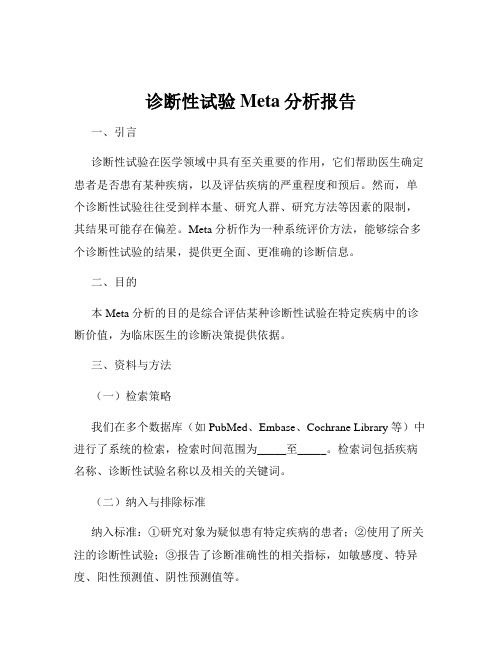
诊断性试验Meta分析报告一、引言诊断性试验在医学领域中具有至关重要的作用,它们帮助医生确定患者是否患有某种疾病,以及评估疾病的严重程度和预后。
然而,单个诊断性试验往往受到样本量、研究人群、研究方法等因素的限制,其结果可能存在偏差。
Meta 分析作为一种系统评价方法,能够综合多个诊断性试验的结果,提供更全面、更准确的诊断信息。
二、目的本 Meta 分析的目的是综合评估某种诊断性试验在特定疾病中的诊断价值,为临床医生的诊断决策提供依据。
三、资料与方法(一)检索策略我们在多个数据库(如 PubMed、Embase、Cochrane Library 等)中进行了系统的检索,检索时间范围为_____至_____。
检索词包括疾病名称、诊断性试验名称以及相关的关键词。
(二)纳入与排除标准纳入标准:①研究对象为疑似患有特定疾病的患者;②使用了所关注的诊断性试验;③报告了诊断准确性的相关指标,如敏感度、特异度、阳性预测值、阴性预测值等。
排除标准:①重复发表的研究;②研究质量差,如样本量过小、方法学存在明显缺陷等;③无法获取全文或关键数据的研究。
(三)数据提取由两名研究者独立提取纳入研究的基本信息(如作者、发表年份、研究地点等)、研究对象的特征(如年龄、性别、疾病严重程度等)、诊断性试验的方法和参数、诊断准确性的指标等。
如有分歧,通过讨论或咨询第三方解决。
(四)质量评估采用 QUADAS-2(Quality Assessment of Diagnostic Accuracy Studies 2)工具对纳入研究的质量进行评估,评估内容包括病例的选择、待评价试验、金标准、病例流程和进展情况等方面。
(五)数据分析使用 Review Manager 53 软件进行数据分析。
对于诊断准确性的指标,计算合并的敏感度、特异度、阳性似然比、阴性似然比和诊断比值比,并绘制森林图和受试者工作特征(ROC)曲线。
采用随机效应模型或固定效应模型进行合并分析,根据异质性检验的结果(I²值)选择合适的模型。
Review-Manager-5实例分析解析教学文案
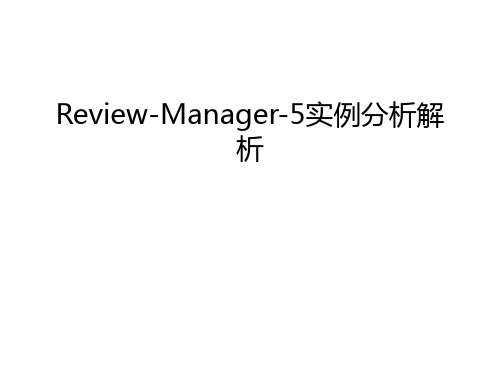
• 点击Finish,弹出如下界面:
• 添加纳入研究
• 点击大纲面板中Studies and reference (研究和参考文献)旁边 钥匙图标,再次点击References to studies(研究的参考文献) 旁的钥匙图标,在Included Studies(纳入的研究)点击鼠标 右键,选择Add study(添加研究)。
• 效应指标的选择:如果数据资料为每一次试验中采用同一 种标准化方法测量得出,则使用WMD,比如,身高、血压、 生化指标等。若各试验数据采用不同的测量工具用不同的 测量单位记录数据时,则用SMD,例如,同一种疾病多种 设计不同的评分量表的情况。
• 连续型变量资料统计分析方法有:方差倒数权重法Inverse variance、D-L法(DerSimonian-Laird)
• RD是指暴露于某种危险因素的观察对象发病危险度与低暴露 或非暴露的观察对象的发病危险度之间的差值——(A/A+B)(C/C+D)
• 效应指标的选择:OR目前常用于病例对照研究(回顾性的病 因学分析);RR适用于队列研究,随机对照试验(前瞻性); RD也适用于随机对照试验(前瞻性)。
• 二分类变量资料常用的分析方法有:方差倒数权重法 Inverse variance、M-H法(Mantel-Haenszel)、Peto法、D-L法 (DerSimonian-Laird)
Review-Manager-5实例分析解 析
Review Manager 5.1为例进行实例讲解
• 通过Revman软件分析结果,评价针刺治疗慢性前列腺炎的有效性, 数据及资料来源于中国知网,下载符合要求的RCT文献数4篇。
• 资料提取如下:
发表 年份
2011 2011 2011 2011
Review Manager操作技术

• 二分类变量资料常用的分析方法有:方差倒数权重法 Inverse variance、M-H法(Mantel-Haenszel)、Peto法、D-L法 (DerSimonian-Laird)
• 输入系统评价的标题 • 以针刺治疗慢性前列腺炎随机对照临床研究为例,在此输 入: • 适合Meta分析的题材:Meta分析最适用于针对同一主题的 RCT文献,这类文献的综合分析结果较为可靠,单个文献 的质量直接决定了Meta分析的价值。
• 选择系统评价的类型 • Full review全文,Protocol草案
•
•
• •
Dichotomous二分类变量(定性资料),录入时需要输入各组发生该事 件或结局的人数与各组的总人数。 Continuous连续性变量(定量资料),录入时需要输入各组的例数,结 局指标的均数及标准差。 O-E and variance期望方差法资料,罕见情况下涉及。 Generic inverse variance倒方差法资料,罕见情况下涉及。
• 点击Finish,弹出如下界面:
• 添加纳入研究 • 点击大纲面板中Studies and reference (研究和参考文献)旁边 钥匙图标,再次点击References to studies(研究的参考文献) 旁的钥匙图标,在Included Studies(纳入的研究)点击鼠标 右键,选择Add study(添加研究)。
• 添加比较: • 在Data and analysises上点击鼠标右键,选择Add comparison • 在弹出的对Add an outcome under the new comparion,点击Continue
• 选择数据类型:
Review Manager 操作技术
系统评价与meta分析之-Review manager-Revman软件使用-水天之间 - DXY
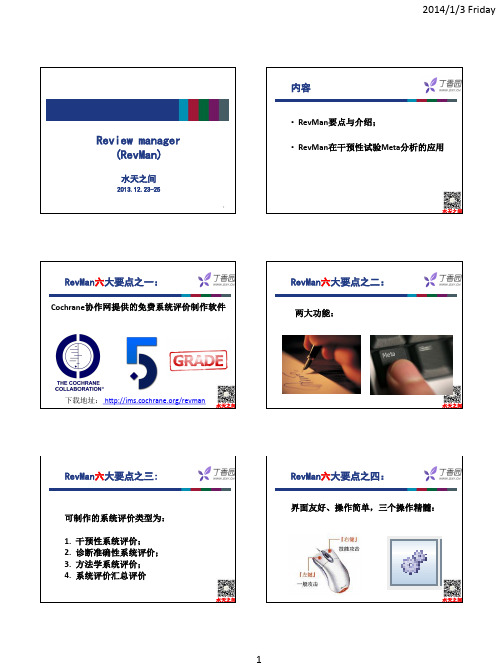
水天之间
RevMan实战—纳入研究风险偏倚及图形
• 表格(Risk of bias table)更改条目:
水天之间
为结局指标添加纳入研究的对话框
水天之间
7
水天之间
RevMan实战—二分类变量meta
2014/1/3 Friday
RevMan实战—二分类变量meta
水天之间
翻转结局标注
水天之间
RevMan实战—二分类变量meta
RevMan实战—二分类变量meta
保存森林图操作
水天之间
二分类数据分析状态下,计算器的计算界面及结果
RevMan实战—“比较”和“结局指标”
RevMan实战—“比较”和“结局指标”
新加结局指标数据类型选择框
水天之间
6
新加结局指标名称及组标签
水天之间
RevMan实战—“比较”和“结局指标”
2014/1/3 Friday
RevMan实战—“比较”和“结局指标”
分析方法选择框
水天之间
分析细节对话框
水天之间
• “Data and analyses”部分为Revman软件 meta分析功能的核心也是重点,在数据分 析下,有三个水平:
1. Comparison; 2. Outcome; 3. Subgroup。
水天之间
RevMan实战—“比较”和“结局指标”
• 增加Comparison同样有两种方法: • 1.鼠标左键点击大纲面板的“Data and
达格列净对2型糖尿病患者血压影响的系统评价
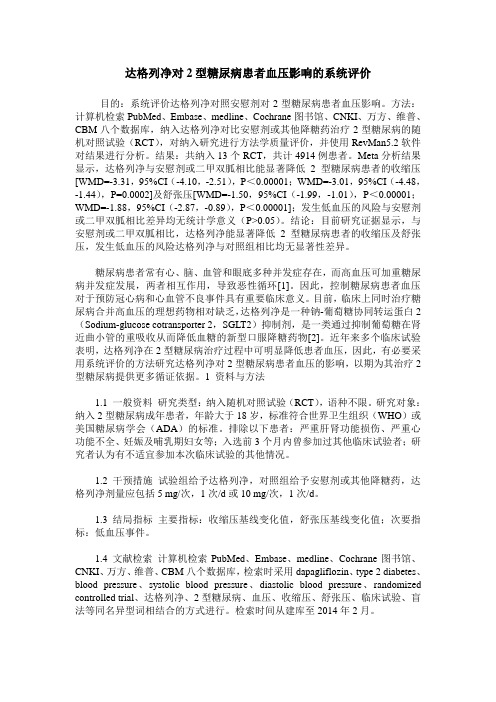
达格列净对2型糖尿病患者血压影响的系统评价目的:系统评价达格列净对照安慰剂对2型糖尿病患者血压影响。
方法:计算机检索PubMed、Embase、medline、Cochrane图书馆、CNKI、万方、维普、CBM八个数据库,纳入达格列净对比安慰剂或其他降糖药治疗2型糖尿病的随机对照试验(RCT),对纳入研究进行方法学质量评价,并使用RevMan5.2软件对结果进行分析。
结果:共纳入13个RCT,共计4914例患者。
Meta分析结果显示,达格列净与安慰剂或二甲双胍相比能显著降低2型糖尿病患者的收缩压[WMD=-3.31,95%CI(-4.10,-2.51),P<0.00001;WMD=-3.01,95%CI(-4.48,-1.44),P=0.0002]及舒张压[WMD=-1.50,95%CI(-1.99,-1.01),P<0.00001;WMD=-1.88,95%CI(-2.87,-0.89),P<0.00001];发生低血压的风险与安慰剂或二甲双胍相比差异均无统计学意义(P>0.05)。
结论:目前研究证据显示,与安慰剂或二甲双胍相比,达格列净能显著降低2型糖尿病患者的收缩压及舒张压,发生低血压的风险达格列净与对照组相比均无显著性差异。
糖尿病患者常有心、脑、血管和眼底多种并发症存在,而高血压可加重糖尿病并发症发展,两者相互作用,导致恶性循环[1]。
因此,控制糖尿病患者血压对于预防冠心病和心血管不良事件具有重要临床意义。
目前,临床上同时治疗糖尿病合并高血压的理想药物相对缺乏,达格列净是一种钠-葡萄糖协同转运蛋白2(Sodium-glucose cotransporter 2,SGLT2)抑制剂,是一类通过抑制葡萄糖在肾近曲小管的重吸收从而降低血糖的新型口服降糖药物[2]。
近年来多个临床试验表明,达格列净在2型糖尿病治疗过程中可明显降低患者血压,因此,有必要采用系统评价的方法研究达格列净对2型糖尿病患者血压的影响,以期为其治疗2型糖尿病提供更多循证依据。
Review Manager4.2 讲义
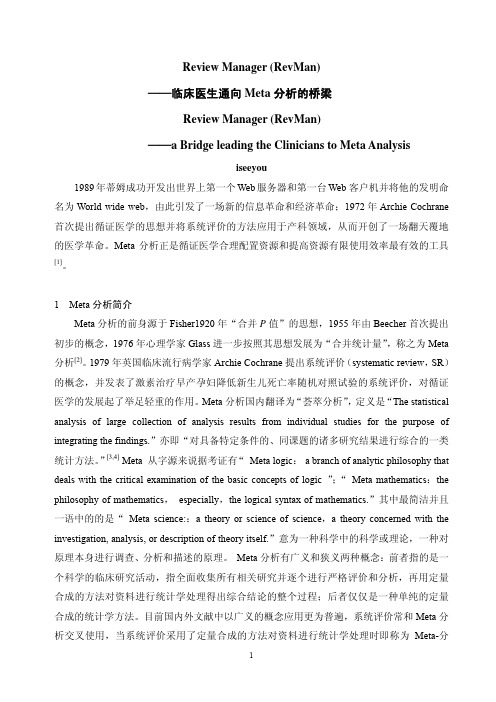
Review Manager (RevMan)——临床医生通向Meta分析的桥梁Review Manager (RevMan)——a Bridge leading the Clinicians to Meta Analysisiseeyou1989年蒂姆成功开发出世界上第一个Web服务器和第一台Web 客户机并将他的发明命名为World wide web,由此引发了一场新的信息革命和经济革命;1972年Archie Cochrane 首次提出循证医学的思想并将系统评价的方法应用于产科领域,从而开创了一场翻天覆地的医学革命。
Meta分析正是循证医学合理配置资源和提高资源有限使用效率最有效的工具[1]。
1 Meta分析简介Meta分析的前身源于Fisher1920年“合并P值”的思想,1955年由Beecher首次提出初步的概念,1976年心理学家Glass进一步按照其思想发展为“合并统计量”,称之为Meta 分析[2]。
1979年英国临床流行病学家Archie Cochrane提出系统评价(systematic review,SR)的概念,并发表了激素治疗早产孕妇降低新生儿死亡率随机对照试验的系统评价,对循证医学的发展起了举足轻重的作用。
Meta分析国内翻译为“荟萃分析”,定义是“The statistical analysis of large collection of analysis results from individual studies for the purpose of integrating the findings.”亦即“对具备特定条件的、同课题的诸多研究结果进行综合的一类统计方法。
”[3,4] Meta 从字源来说据考证有“ Meta logic:a branch of analytic philosophy that deals with the critical examination of the basic concepts of logic ”;“ Meta mathematics:the philosophy of mathematics, especially,the logical syntax of mathematics.”其中最简洁并且一语中的的是“ Meta science::a theory or science of science,a theory concerned with the investigation, analysis, or description of theory itself.”意为一种科学中的科学或理论,一种对原理本身进行调查、分析和描述的原理。
Cochrane系统评价及Review Manager软件简介

❖ 1972年出版的著作-
Effectiveness and Efficiency: Random Reflections on Health Services 明确的提出以下重要论述
由于资源终将有限,因此应该使用已被 证明有明显效果的医疗保健措施
来自于随机对照试验(Randomised Controlled Trials,RCT)的证据,比其它 任何证据更为可靠。
Cochrane系统评价及Review Manager软 件简介
二、系统评价的制作过程
❖ 制订课题计划书(protocol) ❖ 科学背景 ❖ 研究目的 ❖ 纳入标准和排除标准
研究类型 观察对象 干预措施 测量指标
Cochrane系统评价及Review Manager软 件简介
系统评价的制作过程
Cochrane系统评价及Review Manager软 件简介
循证医学
❖ 任何临床的诊治决策,必须建立在当前最好的研 究证据与临床专业知识和患者的价值相结合的基 础上 循证医学就是应用最佳证据的临床医学模式, 要求医务人员具备临床专业知识(clinical skill)、人道主义(humanism)和社会责任感 (social responsibility)
分析和讨论
Cochrane系统评价及Review Manager软 件简介
RevMan软件
❖ Review Manager(简称RevMan)是国际Cochrane协作网为 系统评价(systematic review)工作者所提供的专用软件, 是Cochrane系统评价的一体化、标准化软件。从计算机软 件的角度来看,它主要包括了Cochrane系统评价的英文字 处理与Meta分析两大功能。该软件可以从网上下载,其下 载地址为,目前该软件属免费软件,其最新版本为 “Revman 4.2.10”。
循证医学RevMan(Review,Manager)v4.2课件免费下载
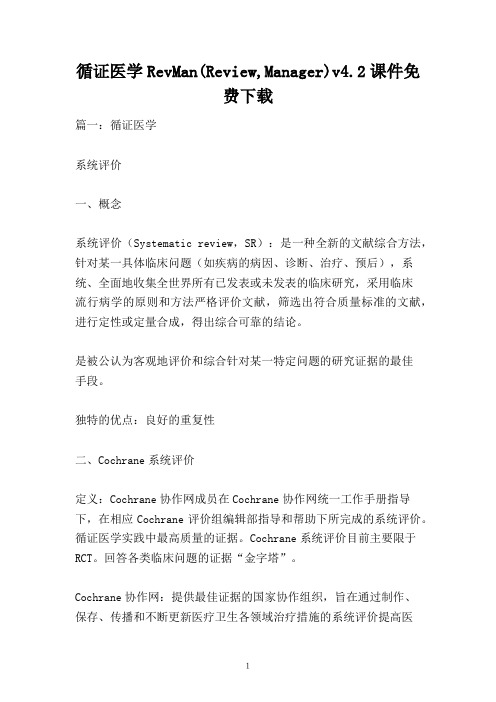
循证医学RevMan(Review,Manager)v4.2课件免费下载篇一:循证医学系统评价一、概念系统评价(Systematic review,SR):是一种全新的文献综合方法,针对某一具体临床问题(如疾病的病因、诊断、治疗、预后),系统、全面地收集全世界所有已发表或未发表的临床研究,采用临床流行病学的原则和方法严格评价文献,筛选出符合质量标准的文献,进行定性或定量合成,得出综合可靠的结论。
是被公认为客观地评价和综合针对某一特定问题的研究证据的最佳手段。
独特的优点:良好的重复性二、Cochrane系统评价定义:Cochrane协作网成员在Cochrane协作网统一工作手册指导下,在相应Cochrane评价组编辑部指导和帮助下所完成的系统评价。
循证医学实践中最高质量的证据。
Cochrane系统评价目前主要限于RCT。
回答各类临床问题的证据“金字塔”。
Cochrane协作网:提供最佳证据的国家协作组织,旨在通过制作、保存、传播和不断更新医疗卫生各领域治疗措施的系统评价提高医疗保健干预措施的效率,帮助人们制定遵循证据的医疗决策。
三、系统评价的分类根据研究的临床问题:病因、治疗、诊断、预后等方面的系统评价根据纳入的原始研究类型不同:临床对照试验和观察性研究的系统评价根据纳入原始研究的方式:前瞻性、回顾性和累积性系统评价根据分析时是否采用统计学方法(Meta分析):定性和定量的系统评价四、为什么要进行系统评价:1. 应对信息时代的挑战、海量信息需要整合2. 及时转化和应用研究成果、连接新旧知识的桥梁3. 提高统计效能、避免“只见树木不见森林”4. 克服传统文献综述的缺陷五、叙述性文献综述(Narrative Review,NR):由作者根据特定的目的和需要或兴趣,收集有关的文献资料,采用定性分析的方法,对论文中阐述的研究目的、方法、结果、结论和观点等进行分析和评价,用自己的判断和观点,整理综合而成文。
《循证医学》ReviewManager使用介绍
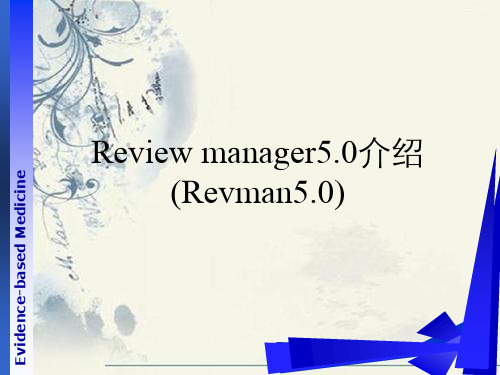
学
院
预
防
医
学
教
研
室
Evidence-based Medicine
Nex t
长
治 医
阿司匹林治疗心肌梗死疗效的meta分析-比较内容
学
院
预
防
医
学
教
研
室
Evidence-based Medicine
Finish
长
治 医
阿司匹林治疗心肌梗死疗效的meta分析-比较内容
学
院
预
防
医
学
教
研
室
Evidence-based Medicine
预
防
医
学
教
研
室
Evidence-based Medicine
Finish
长
治 医
阿司匹林治疗心肌梗死疗效的meta分析-结局变量
学
院
预
防
医
学
教
研
室
Evidence-based Medicine
长
治 医
阿司匹林治疗心肌梗死疗效的meta分析-数据分析
学
院
预
防
医
学
教
研
室
Evidence-based Medicine
学
院
预
防
医
学
教
研
室
Evidence-based Medicine
Finis h
长
治 医
系统评价界面
Title
学
院
预
防
医
学
教
研
室
Evidence-based Medicine
Cochrane系统评价软件RevMan简介

四、未来发展与展望
随着医学和健康科学的不断发展,Cochrane快速系统评价将会更加完善和普 及。未来,可以通过改进和完善Cochrane快速系统评价的方法和标准,提高其准 确性和可靠性。可以进一步拓展Cochrane快速系统评价的应用领域,将其应用于 不同国家和地区的研究中,为全球的医学和健康科学领域提供更加全面和准确的 决策依据。
4、实时更新:Cochrane快速系统评价会随着新研究的出现而不断更新,确 保其结论的时效性和准确性。
二、方法学解读
1、问题定义与目标:首先需要明确评价的目标和问题,确定所要研究的疾 病或干预措施,以及评价的目标人群、结局指标等。
2、文献检索:通过全面的文献检索,收集所有相关的研究。Cochrane快速 系统评价通常采用计算机辅助检索和手工检索相结合的方式,以确保检出所有相 关研究。
也需要注意合理使用图形和遵循伦理规范等问题。通过正确使用RevMan和其 他相关工具和方法,我们可以更好地总结和传播临床医学和其他领域的研究证据, 从而为提高医疗质量和促进科学发展做出贡献。
参考内容
关键词:Meta分析,RevMan软件,学术研究,统计分析
在当今学术研究领域,Meta分析被广泛认为是有效的统计方法之一,可用于 汇总和评估先前的研究结果。这种分析方法通过合并多个独立研究的结果,以提 供更全面、更可靠的总体估计。与此同时,Meta分析的流程和方法也经历了不断 的发展和优化。本次演示将介绍Meta分析的基本概念、优点及其在学术研究中的 应用,并探讨使用RevMan软件进行Meta分析的实践方法。
3、高效可靠:CDEGS软件采用了先进的计算方法和算法,确保计算结果准确 可靠。
4、兼容性好:CDEGS软件可与多种主流的工程软件进行无缝对接,如 AutoCAD、ANSYS等。
Cochrane系统评价及RevMan软件简介
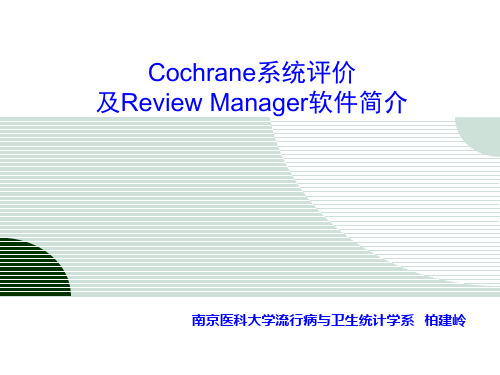
结论(Conclusion)
三、怎样使用系统评价证据
确定某系统评价的适用范围和条件 评价系统评价的质量
是否进行了广泛的检索 是否对纳入研究进行了正确的质量评价 合并分析是否正确 是否对纳入研究和本系统评价的局限性进行了充分的 分析和讨论
RevMan软件
Review Manager(简称RevMan)是国际Cochrane协作网为 系统评价(systematic review)工作者所提供的专用软件, 是Cochrane系统评价的一体化、标准化软件。从计算机软 件的角度来看,它主要包括了Cochrane系统评价的英文字 处理与Meta分析两大功能。该软件可以从网上下载,其下 载地址为/RevMan/download.htm,目 前该软件属免费软件,其最新版本为“Revman 4.2.10”。 该软件的主要特点是可以制作和保存Cochrane系统评价的 计划书和全文;可对录入的数据进行Meta分析并以 Metaview(森林图)的分析结果以图表形式展示;可对 Cochrane系统评价进行更新;可以根据读者的反馈意见不 断修改和完善。
Included study
Included study
④在“Included study”对话框中,在“Study ID”信 息框中输入纳入分析的每一个研究名称及发表的 年份(可省略),然后按“OK”,每一次操作只 能输入一个研究名称;如Fleiss JL的资料,共有七 个纳入分析的研究,故 -> Archie Cochrane 教授倡导应依据特定地疾病及 治疗方法,搜集并分析所有相关的随机对照试验,同时随 着新数据的出现不断更新,以便获得更为可靠的结论。 1980 -> 加拿大著名临床流行病学家 David Sackett 教授 将临床流行病学的方法和原理实际应用于临床指导,以提 高临床疗效,为循证医学的方法学奠定重要基础。 1992 -> 全世界第一个 Cochrane中心在 National Health Service (NHS)的资助下于牛津大学成立,旨在促进及协 调医疗保健方面随机对照试验系统评价的生产和保存,以 便依据最好的科学进展和研究结果服务于临床医疗、卫生 管理和高层决策。 1993 -> Cochrane Collaboration 正式成立。
RevMan5操作手册【范本模板】
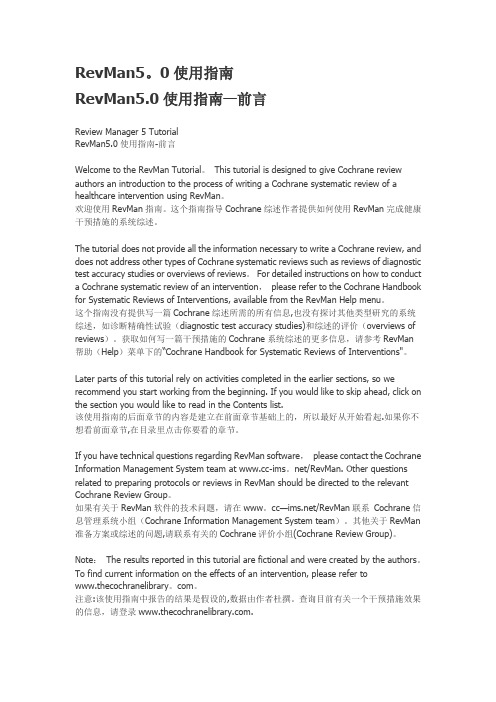
RevMan5。
0使用指南RevMan5.0使用指南—前言Review Manager 5 TutorialRevMan5.0使用指南-前言Welcome to the RevMan Tutorial。
This tutorial is designed to give Cochrane review authors an introduction to the process of writing a Cochrane systematic review of a healthcare intervention using RevMan。
欢迎使用RevMan指南。
这个指南指导Cochrane综述作者提供如何使用RevMan完成健康干预措施的系统综述。
The tutorial does not provide all the information necessary to write a Cochrane review, and does not address other types of Cochrane systematic reviews such as reviews of diagnostic test accuracy studies or overviews of reviews。
For detailed instructions on how to conduct a Cochrane systematic review of an intervention,please refer to the Cochrane Handbook for Systematic Reviews of Interventions, available from the RevMan Help menu。
这个指南没有提供写一篇Cochrane综述所需的所有信息,也没有探讨其他类型研究的系统综述,如诊断精确性试验(diagnostic test accuracy studies)和综述的评价(overviews of reviews)。
word版Reviewer manager的使用图解说明
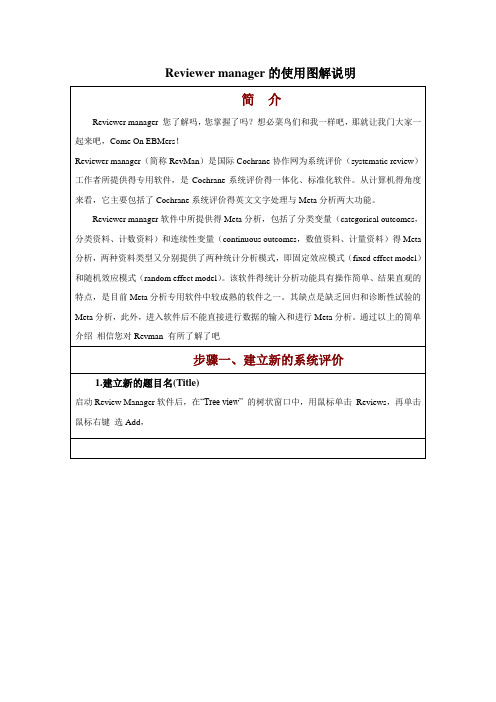
与导入是相反的,这里就省了吧。战友们可以自己尝试一下哦
6.导入参考文献
逐级展开File→Import→Refereances→再选择“Tagged text foumat"或” Vancouver format“然后找到所导入文献的存盘路径后选择并点击OK
在”Tree view”窗口中,用鼠标点击用户定义分支名aspirin for miocardial infarction前的“+“号,可逐级展开其下级分支,如图所示
2.建立封面
在上面展开的图中双击“Cover sheet”再在其五个小分支中再双击“Reviews”栏目
然后如下图,在“Reviews“对话框中,使用者可逐个编辑和输入其”Contacts“”Co-reviewers“”Contribution“内容,完成后单击”Save”存盘,单击”Colse”退出返回主窗口(注:如出现Mark change其处理方法同上)
以上为完成一个Cochrane评价书的全部主要操作,操作完成后,您就可以导出并将其发送相关评审组了
4.导出系统评价或评价书
逐级展开File→Export→Selected reviewers→下图
在从下图的对话框中选择需要导出的系统评价或计划书(本例只有一例哦)
然后按OK后出现Save as对话框中导出文件命名后,并单击保存。(注意:RevMan4的被导出的文件名默认为“.rm4”
ห้องสมุดไป่ตู้步骤一、建立新的系统评价
1.建立新的题目名(Title)
启动Review Manager软件后,在“Tree view”的树状窗口中,用鼠标单击Reviews,再单击鼠标右键选Add,
这时系统在“Review”图标下建立了一个”New review“分支产生,同时产生”Title(New review)“对话框。然后在“Title”信息框输入研究信息的名称:aspirin for miocardial infarction(Fleiss JL的阿斯匹林(aspirin)预防心肌梗死的研究资料为例,使用Review Manager软件对该资料进行Meta分析)
Review Manager 5软件在诊断准确性试验的Meta分析中的应用
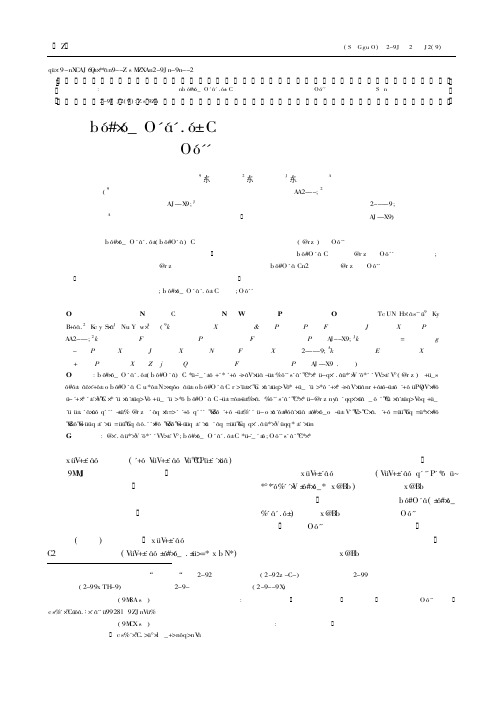
� � � � � � � � � � � � � � 4 � 42000 � � � ;2D � � � � � � � � U � � � � , � � � � � � � � � H , U , , H 4 30071; 3 D N � � � � � � � � � � � � � � � , R � H � � � � � � � , � S� � � � � � � M� � � � � � , � S � � � � J U , S 200001; 4D E , S � � � � � � � � � � � � � � � P H � � � � S K L V , U , , H 4 3 0071, C ) A : R evi ew M a na g er ( R evM a n) 5 sof twa r e ha s the f unc ti on f or meta -a na l ysi s ofdi a g nosti c test a c c ur ac y ( DT A ) , however , nei ther " R evM a n 5 UserGui de" nor " R evM a n 5 T utor i al " i ntr oduc es how to use thi sf unc ti on.T her ef or e, the obj ec ti ve of thi sar ti c l ei s to i ntr oduc e how to use R evM a n 5 f or per f or mi ng meta -ana l ysi s ofDT A .I n a ddi ti on , we al so i ntr oduc ed how to or g a ni ze da ta f r om D T A a nd i nput the da ta l i k e the f or ma t of " i nter venti on r evi ew" f or c al c ul a ti ng the pool ed posi ti ve l i kel i hood r a ti o, pool ed nega ti ve l i k el i hood r a ti o, a nd pool ed di a gnosti c odds r a ti o. K : Di ag nosti c test a c c ur ac y ; R evi ew M a na g er5 sof tw a r e ; M eta -a nal ysi s
培训学习资料-ReviewManager实例分析_2023年学习资料
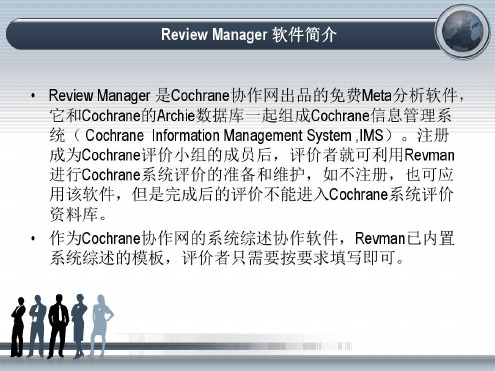
0-选择系统评价的类型:-Intervention review于预评价-Diagnostic test ccuracy review诊断试验精确评价-Methodology review方法学评价-Overvi w of reviews同类综述评价-New Review Wizard-☒-Which type of eview do you want to create?-Type of Review:-ODiagnos ic test accuracy review-◈Overview of reviews-Cancel-÷ ack-Next>-Finish
·新建一个系统评价,File----New-Edit Format-View-Tools Table-Wi dow-Help-9-Ctrl-N-的-open...-Ctrl-O-Recent Files-Close
点击N to the New Review Wizard-This wizard helps you create a new revi w for other purposes than publication in The Cochrane Library.-If you want to create a Cochrane review for ublication,please contact the appropriate Review Grou .-To continue,click Next.-Cancel-Back-Next>-Finish
Review Manager5.1为例进行实例讲解-通过Revman?软件分析结果,评价针刺治疗慢性前列腺 的有效性,-数据及资料来源于中国知网,下载符合要求的RCT文献数4篇。-资料提取如下:-发表-研究质-试验 -对照组-年份-作者-量评估-总数-2011-陈鹏典-31-32-30-陈云龙-28-23-文翠芬-744-46-朱伟-43-29
Revman软件操作

我们来看一下结果
总的事件数及 样本量
合并的效应量及 95%可信区间 总OR值的统计学 检验(Z检验)结 果,总OR值的P值
异质性检验:P=0.42,I2=0%, 说明无明显异质性
下面来介绍一下这几个小 按钮的功能
这个按钮可以用来添 加新的研究
这个按钮可以切换 效应指标,也就是 OR、RR、RD
开始数据分析,点Add comprison
为这个对比 取一个名字, 如“A vs B”
比较已经建好, Add outcome
二分类变量 O-E和方差
连续型变量
一般倒方差
其他数据类型
二分类变量和连 续型变量是最常 用的
点“Dischotomous”, 然后 next
为这个结果取一 个名字,如这个 结果是分析安全 性,如:Safety
Lacher-2008
German
Caucasians
rs7517847 rs11209026
Marquez-2007
Spain
CaucasiansБайду номын сангаас
s7517847 rs11209026
Latiano-2008
Italy
Caucasians
rs7517847
rs11209026
Oliver-2007 Spain Caucasians rs7517847 rs11209026 rs1343151 Ebrahimi-2014 Iran Asian rs7517847 rs11209026 rs1004819 rs1343151 rs2201841
这一界面主要选择: 1.统计学方法 2.统计模型 3.统计指标
统计学方法 Peto:只能用于二分类变量 里的OR值 MH法:只能用于二分类变量 IV法:连续型变量和二分类 变量都可以
诊断性试验的系统评价及统计方法
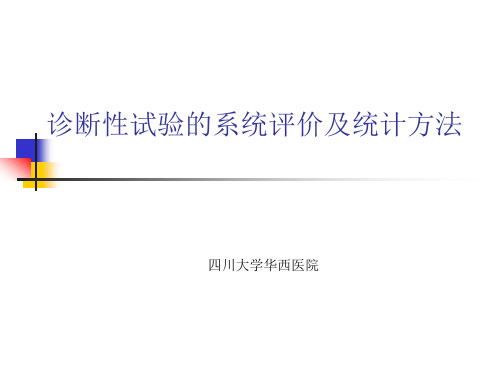
不规范的诊断性问题
宫颈胎儿纤维蛋白检测有用吗?
背景? 对象? 目的? “有用”如何定义?
结构式问题
诊断试验方法 (Index test)
宫颈胎儿纤维蛋白检测阳性能否用于预测无症状妇女的自发性早产?
Populations of interest
Methods Criteria for considering studies for this review Types of studies Participants Index tests Comparator tests Target conditions Reference standards Search methods for identification of studies Electronic searches Searching other resources Data collection and analysis Selection of studies Data extraction and management Assessment of methodological quality Statistical analysis and data synthesis Investigations of heterogeneity Sensitivity analyses Assessment of reporting bias
有病 无病
阳性 a
b
待评诊断试验
阴性 c
d
预测值的特点
敏感度越高的试验,阳性预测值越高; 特异度越高的试验,阴性预测值越高; 患病率的高低对预测值的影响更大。
Review+Manager(RevMan)--临床医生通向Meta分析的桥梁
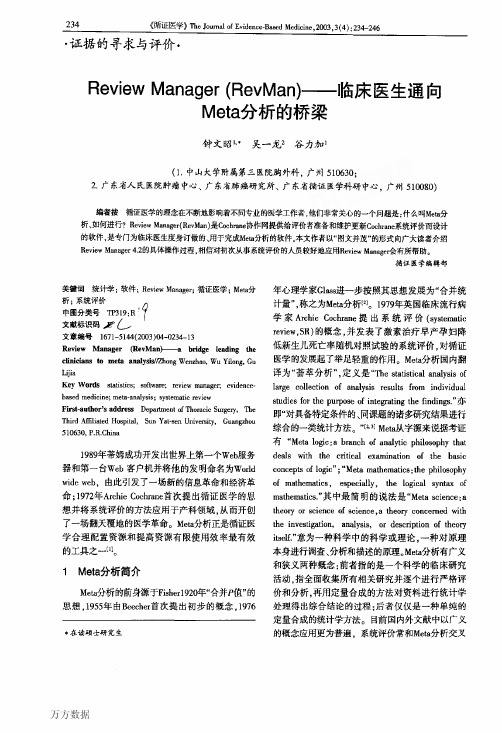
万方数据
钟文昭,等.Review Manager(RevMml)--1临床医生通向Meta分析的桥梁
235
使用,当系统评价采用了定量合成的方法对资料进 行统计学处理时即称为Meta分析。因此,系统评价可 以采用Meta分析(quantitative systematic review,定量 系统评价),也可以不采用Meta分析(non—quantitative systematic review,定性系统评价)“.5】。参照Cochrane 协作网系统评价工作手册(Cochrane Reviewers’ Handbook,免费下载网址:bttp://www.eochmne.org, cochrane,qabook.htm)制定的统一标准,Meta贫"析的基 本步骤如下:
Third Affiliated Hospital,Sun Yat-sen University,Guaagzhou
510630.P.R.China
1989年蒂姆成功开发出世界上第一个web服务 器和第一台Web客户机并将他的发明命名为World wide web,由此引发了一场新的信息革命和经济革 命;1972年Archie Coehrane首次提出循证医学的思 想并将系统评价的方法应用于产科领域,从而开创 了一场翻天覆地的医学革命。Meta分析正是循证医 学合理配置资源和提高资源有限使用效率最有效 的工具之一【1]n
the investigation,analysis,Or description of theory
itself.”意为一种科学中的科学或理论.一种对原理 本身进行调查、分析和描述的原理。Meta分析有广义 和狭义两种概念:前者指的是一个科学的临床研究 活动.指全面收集所有相关研究并逐个进行严格评 价和分析,再用定量合成的方法对资料进行统计学 处理得出综合结论的过程;后者仅仅是一种单纯的 定量合成的统计学方法。目前国内外文献中以广义 的概念应用更为普遍.系统评价常和Meta分析交叉
- 1、下载文档前请自行甄别文档内容的完整性,平台不提供额外的编辑、内容补充、找答案等附加服务。
- 2、"仅部分预览"的文档,不可在线预览部分如存在完整性等问题,可反馈申请退款(可完整预览的文档不适用该条件!)。
- 3、如文档侵犯您的权益,请联系客服反馈,我们会尽快为您处理(人工客服工作时间:9:00-18:30)。
Review Manager 5.2 Tutorialfor Diagnostic test accuracy reviewsSeptember 2012Welcome to the RevMan Diagnostic test accuracy (DTA) Tutorial. This tutorial is designed to give Cochrane review authors an introduction to the process of writing a Cochrane systematic review of the accuracy of diagnostic tests using RevMan.The tutorial does not provide all the information necessary to write a Cochrane DTA review, and does not address other types of Cochrane systematic reviews such as reviews of intervention studies or overviews of reviews. For detailed instructions on how to conduct a Cochrane DTA review, please refer to the Cochrane Handbook for Diagnostic Test Accuracy Reviews, available from the following website.Later parts of this tutorial rely on activities completed in the earlier sections, so we recommend you start working from the beginning. If you would like to skip ahead, click on the section you would like to read in the Contents list. The approximate time needed to complete this tutorial will be about three to four hours.If you have technical questions regarding RevMan software, please contact the Cochrane Information Management System team at /revman. Other questions related to preparing protocols or reviews in RevMan should be directed to the relevant Cochrane Review Group.About this tutorialThe tutorial for Cochrane diagnostic test accuracy reviews in RevMan 5 was developed by Mariska Leeflang in 2010, with assistance from the Australasian Cochrane Centre and the UK and Continental European Support Unit for diagnostic test accuracy reviews, and with funding from The Cochrane Collaboration Steering Group. The tutorial was revised in February 2011 to incorporate new features of RevMan 5.1 and in September 2012 for new features of RevMan 5.2. Please note that the results reported in this tutorial are fictional and were created by the authors for teaching purposes only. Note about using mouse right-clicksMany of the functions in RevMan that involve selecting a button on the outline pane toolbar can also be achieved by right-clicking the sub-headings in the outline pane and selecting the function from the drop-down list.PART 1 – Getting started (5)Opening your review (5)Setting up user details (6)The RevMan 5.2 interface (6)Saving a review (8)Adding authors to a review (8)Accessing the Cochrane Handbook for Diagnostic Test Accuracy Reviews (9)PART 2 – Working with text (11)Adding text to a review (11)Formatting text (11)Making changes to headings (11)Adding notes (12)Tracking changes in the text (12)Checking your spelling (13)PART 3 – Adding studies and references (15)Adding studies to a review (15)Adding references to a study (15)Editing an existing reference (17)Importing references from a text file (18)Moving references (18)Adding links to references in the text (19)Removing a link (20)Adding multiple links automatically (20)PART 4 - Tables (21)Characteristics of included studies tables (21)Patient selection (21)Index Test, Reference Standard, and Flow and Timing (22)Editing the Characteristics of included studies table (22)Adding user-defined items (23)Characteristics of excluded studies (24)Adding Footnotes to tables (25)Additional tables (25)PART 5 - Data and analyses (27)Adding tests (27)Entering data by test (28)Entering data using the calculator (29)Entering data by study (30)Assessment of methodological quality for two tests (32)Covariates (33)Analyses (35)a. Changing Forest Plot properties (36)b. Changing SROC Graph properties (37)c. Entering Externally Calculated Parameters (38)Test Comparisons (38)Paired Test Comparisons (40)Investigating heterogeneity (41)Adding a figure to your review (42)Risk of bias and applicability concerns graph and summary (43)PART 6 – Finishing the review (44)Summary of Findings tables (44)Adding an appendix (44)Validating a review (44)Submitting a review for editorial approval (45)Appendix – To convert to QUADAS-2 from QUADAS (46)PART 1 – Getting startedOpening your reviewAll Cochrane reviews are stored in Archie, The Cochrane Collaboration’s central server for managing documents and contacts details. When you have registered a review with a Cochrane Review Group, they will set up a user account for you in Archie. To work on your review, you will need to find your review online in Archie and check it out into RevMan using the My Reviews button on the toolbar. Doing this opens a new window which provides information on the location of your reviews and what the next task for your review is. In this window you can check a review outby selecting the title and pressing the Check Out button.Before going ahead it is important to make sure that RevMan is currently in‘Standard’ mode rather than ‘Non-Cochrane’ mode. ‘Non-Cochrane’ mode is a preference that allows users to specify that they are using RevMan to author reviews that will not be published in The Cochrane Library. In ‘Non-Cochrane’ mode, all Cochrane-specific functions like check in/out and connection settings to Archie are absent from the interface. To complete this tutorial you need to be in ‘Standard’ RevMan mode.1.From Tools menu on the toolbar, select Preferences which will open thePreferences window.2.Under User mode on the General tab, confirm that the Non-Cochrane modeoption is NOT checked.3.If the Non-Cochrane mode option is checked, uncheck it and press OK. Awarning will appear indicating that “Not all changes may take effect until you restart the program”. Click OK, and Exit out of RevMan and restart it.4.If the Non-Cochrane mode option is NOT checked, simply click OK.For this tutorial we will use a sample review called ‘Laboratory tests for caffeine addiction in PhD students’. Instead of checking the review out of Archie, it has been provided as an additional file with RevMan 5.2.1.From the File menu, select Open, or click the Open button on the toolbar.2.Find the folder where RevMan was installed on your computer. If you areusing Windows and accepted the default installation location, this will beC:\\Program Files\Review Manager 5. If you are using Mac OS or Linux, thetutorial files are copied to a subfolder of your home directory named‘RevMan tutorial’.3.Open the doc folder, and then the tutorial folder.4.Select the file ‘Laboratory tests for caffeine addiction in PhD students.rm5’.5.Click Open.button on the toolbar. Be aware that if you create a review yourself, you cannot check it into Archie or use it for publication inSetting up user detailsIf you will be using RevMan regularly on the same computer, you may wish to enter your user details (such as your name). RevMan will attach these user details to any editing done using track changes so that co-authors and editors can easily identify who has made the changes. Open your user details by selecting Preferences from the Tools menu. Enter your name directly or click Choose to find your details in Archie.The RevMan 5.2 interfaceWhen a review is open in RevMan 5.2, you will see there are two separate window panes that interact with each other as you navigate through the different sections of a review. The pane on the left hand side shows the outline of a review. This is referred to as the outline pane. The area on the right hand side shows all the information contained in a review. This is referred to as the content pane. The content pane will usually show the text of your review, but can also contain additional tabs for results, figures, etc.In the outline pane, you can use the key icon next to each heading to expand and collapse subheadings. In the content pane, use the symbol.RevMan allows you to change the appearance of the interface by selecting Preferences from the Tools menu and going to the Interface tab. The default Look and Feel of the interface is Metal. All screen captures presented in this tutorial display the Metal look and feel. It is also possible to set language and spelling options in the Preferences window.By default, your new review is at the protocol stage, indicating that you are planning the methods for a review. Sections of a review that are not required at the protocol stage (but will be needed later for your completed review) appear as inactive (light grey) in both the outline pane and the content pane.or review icon at the topWhen you undertake a Cochrane review, the protocol must be completed and submitted for publication before moving on to the review stage. For this tutorial, to convert the file from the protocol stage to review stage, use the following directions:1.Click the Properties button in the top-right of the content pane.2.In the Properties window, select the General tab.3.Note the automatically generated Version Number – this number will changeeach time the review is checked into Archie. Note that you do not need aseparate Review Number unless your Review Group provides one.4.Enter the Version Description ‘First draft’. When choosing a versiondescription, make sure it is brief and clearly indicates what’s different aboutthis draft, e.g. ‘Edited by [your initials]’ or ‘Methods section complete’.5.For the Stage, select Full Review.6.Click OK. Note that all of the section headings of the review are nowactivated for inclusion (there are no light grey section headings).Saving a reviewWhen you have finished working on a review from Archie, we recommend that you always save the review by checking it back into Archie using the Check In button on the toolbar. This ensures the most recent version of your review is safely stored and can always be accessed from Archie by your co-authors and editors.We recommend that you do not keep saved reviews on your computer, to avoid confusion with different versions. Be careful not to use a version of your review from your computer if a more recent version is available in Archie. If for some reason you do need to save a review to your computer, such as this tutorial review which is notfrom Archie, go to the File menu and select Save As, or click the Save button on the toolbar. You can open a saved review by going to the File menu and selecting Open, or clicking the Open button on the toolbar.RevMan also creates automatic backups of your review. See the Help menu for information on retrieving a backup file.Adding authors to a reviewFor a real review, your Review Group will add your name as an author of the review when they create the file, along with any known co-authors. You may wish to add additional authors later.There are two ways to add authors to a review:•Add an author based on their record in Archie – this option allows you to add authors who are already listed in the Archie database. You will need tohave internet access and an Archie user account for this option.•Add a local record (name only) that can be linked to Archie later – this option allows you to add authors that are not yet listed in Archie.1.In the content pane, click the icon next to the Review information headingto show further subheadings.2.Click the icon to open the Authors section. Note that three authors havealready been added to this review.3.In the outline pane, click the key icon next to Review information.4.Select the Authors heading.5.Click the Add Author button on the outline pane toolbar to open the NewAuthor Wizard.6.Select Add a local record (name only) that can be linked to Archie later. ClickNext.7.Enter your name in the First Name and Family Name fields.8.Click Finish. You will now see your name listed next to the other authors ofthe review. Note that no affiliation is available for your name. Affiliations canonly be added from records in Archie.Under the author details in both the outline and content panes you will note that a Contact person can be specified for the review. By default, this is the first author, but another person (who may or may not be an author of the review) can benominated by selecting the Contact person heading in the outline pane and clickingthe Edit Contact Person button on the outline pane toolbar. The contact personmust be listed in Archie.Accessing the Cochrane Handbook for Diagnostic Test Accuracy ReviewsFor detailed instructions on what to report in each section of your review, you canrefer to the Cochrane Handbook for Diagnostic Test Accuracy Reviews. This can beaccessed from the Help menu, or by clicking the Handbook button in the topright-hand corner of the content pane, which will open a new window that will allowyou to browse through all sections of the Handbook. A particular section of the Handbook can be opened in the new window depending on which section of the Main text you are working on.1.In the outline pane, if it is not already expanded, click the key icon next tothe Main text heading.2.Click on the word Abstract.3.In the content pane, click the Handbook button (or right click and selectHandbook). Note that the Cochrane Handbook for Diagnostic Test Accuracy Reviews window has opened at the section with guidance on what to write in the abstract of the review.4.Close the Cochrane Handbook for Diagnostic Test Accuracy Reviewswindow.PART 2 – Working with textAdding text to a reviewText can be copied and pasted from a word processor document, imported as an html file or typed directly into RevMan.1.In the content pane, if it is not already expanded, click the icon next to theBackground heading.2.Click the icon next to the Target condition being diagnosed heading. Ablank line will open under the heading.3.Click to place the cursor in the blank line and type “Caffeine addiction is acommon problem that affects productivity of PhD students, mainly due totoo much talking at the coffee machine.”Formatting textRevMan text formatting options are available from the toolbar, including bold , italics , underline , superscript , subscript , and highlighting text similar to most other word processing software. You cannot change the font or type size, as these are standard for all Cochrane reviews.The Insert Symbol button allows you to insert symbols into the text of the review, including in tables and author names. You can also insert a non-breaking space. RevMan also allows bulleted and numbered lists , including multi-level lists. Making changes to headingsRevMan includes the standard headings for a complete Cochrane review, but new headings can be added and some standard headings can be deactivated.1.In the outline pane, click the key icon next to Main text to reveal thesubheadings.2.Click the key icon next to Background.3.Click the key icon next to Clinical pathway.4.Any heading with the icon is optional and can be deactivated. Right-clickthe Alternative tests subheading and select Deactivate Heading(alternatively, select the heading Alternative test(s) then click the buttonon the outline pane toolbar and select Deactivate Heading from the dropdown menu).5.Note that the heading appears deactivated (light grey) in the outline paneand the text of the heading has been removed from the content pane.6.In the content pane, click to place the cursor at the end of the text in theTarget condition being diagnosed section and press Enter to create a newline.7.On the toolbar, you will see a drop-down box showing the text style currentlyin use. By default, text is in the Normal style. Click the drop-down arrow andselect Heading 3.8.Type the text ‘Reference standard’. Note that formatting of Heading 3 is boldand italics.9.Press Enter again. Note that the new blank line is in the Normal style again. Adding notesYou can add notes to assist in drafting the review. These notes will not appear in the published version of the review.1.In the content pane, make sure the cursor is still in the Background section.2.Click the Notes button on the outline pane toolbar (NOT the Notes buttonin the content pane). This will open the Notes window.3.Enter a note, ‘This text needs revision.’ You will see the user details youentered in the Preferences window at the beginning of the tutorial appearsat the bottom of the Notes window.4.Click the Close button to save the note and close the window.5. A yellow Note icon appears next to the relevant heading in both thecontent pane and outline pane.6.To see all the notes for a review while you are working, go to the View menuand select Notes. A separate window pane will appear below the contentpane showing the notes for each section.7.In the content pane, click to place the cursor back in the Background section.The notes area will automatically display the note you have entered in thatsection.8.Click the icon at the top left of the notes area to minimise it, or go to theView menu and select Notes to close the notes pane.9.In the content pane, click the Note icon to open the Notes window again.10.Click Delete to delete the note.Tracking changes in the textRevMan has a Track Changes system to help you manage editing in the text.1.From the Tools menu, select Track Changes, or click the Track Changesbutton on the toolbar. Note that the Track Changes button is now activated.2.In the content pane, go to the Background section and replace the word‘problem’ with the word ‘condition’. The old text will appear in red with a line through it, and the new text will appear in green.3.In the same section of the review, change the word ‘at’ to ‘by’. Leave thecursor in the text after your changes.4.From the Tools menu, select Accept or Reject Changes. This will open theAccept or Reject Changes window.5.In the window you just opened, click the Find button with the arrow pointingleft to search backwards toward the beginning of your document.6.The first change found will be the word ‘function’. The word will behighlighted in the content pane. You may need to move the Accept or Reject Changes window out of the way to see the highlighted section of text. ClickAccept to accept the change.7.RevMan will automatically find the next change and highlight the relevanttext. Click Accept again to accept the deletion of the word ‘at’.8.Reject the rest of the changes you made by clicking the Reject All button.9.Click OK.10.In the content pane, change the word ‘problem’ to ‘condition’ again.11.Hover the mouse pointer over the change. A popup message will appearshowing the user details and when the change was made.12.Right-click each change (both the added word and deleted word) and selectAccept Change.13.Turn off the Track Changes feature by clicking the Track Changes buttonon the toolbar.Checking your spellingRevMan can either check your spelling as you type, or check all the spelling in your review at the one time.1.From the Tools menu, select Preferences.2.Select the Spell Checking tab.3.Select which dictionaries you would like RevMan to use, including UK, US orCanadian English. You can select more than one dictionary if you wish.4.Click OK.5.In the content pane, create a spelling mistake by deleting an ‘m’ from theword ‘common’.6.Open the Tools menu and select the Check Spelling option. This will open theCheck Spelling window.7.Depending where your cursor was placed, RevMan may ask whether you wishto continue checking from the beginning of the document. Click Yes.8.RevMan will highlight the spelling mistake and suggest ‘common’ as thecorrect spelling. Click Change.9. A notice will appear to say that the spell check is complete. Click OK.10.Click OK again to close the Check Spelling window.11.To check spelling continuously while you type, go to the Tools menu andselect Check Spelling as You Type, or click the Check Spelling as You Type button on the toolbar.12.Delete the ‘m’ from ‘common’ again, and click to place the cursor elsewherein the text. The spelling mistake will be underlined in red.13.To correct the word, right-click it and select the correct spelling from theoptions available.PART 3 – Adding studies and referencesThere are two kinds of references that can be added to a review:•References to studies – these are references to studies that have been either included or excluded from your review. A study can have more than onereference, for example if there has been more than one published paper, or if you have received additional information from the study author.•Other references – these are any other source you would like to cite in your review, such as background articles, methodological references, software,etc.Adding studies to a reviewWhen you are ready to add included and excluded studies to your review, you will need to create a Study ID for each study, and then add the associated references. For Cochrane reviews, the Study ID is usually the name of the lead author of the main published paper and the year of publication. If you have more than one reference with the same name and year, you can add a letter to the year to differentiate them(e.g. Egberts 2001a, Egberts 2001b).1.In the outline pane, click the key icon next to Studies and references.2.Click the key icon next to the Reference to studies section. You will seethat there are already some studies included.3.Select Included studies and click the Add Study button on the outlinepane toolbar. This will open the New Study Wizard.4.Enter the Study ID ‘Dorlas 2006’ and click Next.5.From the Data source drop-down list, choose Published and unpublisheddata. Click Next.6.The year the study was conducted will appear by default as ‘2006’. Click Next.7.If your study has an ID number, such as a document ID, you can enter it hereby clicking the Add Identifier button, selecting an ID type from the drop-down list, and entering the ID.8.Click Next.9.Select Add another study in the same section and click Finish.10.Repeat steps 4-9 and add the following studies to the tutorial review:Egberts 2001Levelt 2007Smit 200611.When you have added the details for the last study, instead of step 9, selectNothing and click Finish.12.In the outline pane, click the key symbol next to Included Studies to seethe new studies listed.Adding references to a study1.In the outline pane, select the Dorlas 2006 study.2.Click the Add Reference button on the outline pane toolbar. This will openthe New Reference Wizard.3.By default, the Reference Type is set to Journal article (click the drop-downlist to see the other options available). Click Next.4.Enter the following details in the form provided (note that fields appearing inbold are mandatory):Authors: Dorlas S, Egberts DEnglish title: Questionnaires to measure caffeine addictionJournal/book/source: Journal of Addictive ResearchDate of publication: 2006Volume: 15Issue: 4Pages: 567-715.Click Next. As for a study, you will have the option to add an ID number forthe reference, such as a MEDLINE reference number.6.Click Finish. The reference will now appear in the content pane. In the outlinepane, click the key symbol next to Dorlas 2006 to see the new reference listed.Editing an existing reference1.In the outline pane, double-click the reference listed under the Dorlas 2006study (or right-click and select Edit Reference).This will open a new tab in the content pane showing all the details you entered.2.Open the Reference Type drop-down box and change the type from ‘Journalarticle’ to ‘Book’. Note that the fields have changed and some rows are nowshaded. Shaded rows will not appear in your published review.3.Change the reference information to the following (you need to scroll downto see some of these fields):Authors: Dorlas S, Egberts DJournal/book/source: Measuring caffeine addictionDate of publication: 2006Publisher Name: Grinder PressCity of publication: London4.At the bottom of the reference tab, note that the reference is displayed as itwill appear in the published review. Note that this display changes as youmake the changes to the reference. Check that the reference appearscorrectly.5.Go to the tab header and click the button next to the first author’s name toclose the reference tab (do not click the button at the top right corner asthis will close the review).Importing references from a text fileIf you have already entered your references in another program, you can avoid typing them in again by importing them from a text file. A sample text file has been provided with RevMan 5 for this tutorial.1.Go to the File menu and select Import, then References. This will open theImport References Wizard.2.Click Next.3.RevMan should automatically open the same folder we used to open thesample review: c:\\program files\review manager 5\doc\tutorial. Select the file ‘DTA Study References.txt’ and click Open.4.You will see a preview of the text file. Click Next.5.By default, RevMan Format is selected as the format of the text file (otheroptions include RIS or PubMed MEDLINE formats). Click Next.6.By default, RevMan will save references to the Classification pendingreferences section, under Other References in the outline pane. Referencesin this section will not appear in the published review (for this reason theyare shown in grey). Click Next.7.If you wish, you can assign different locations for each individual reference,or exclude specific references from the text file while importing the rest. Forthis tutorial, leave the settings as they are and click Finish.8.RevMan will report that 8 references have been imported. Click OK.9.In the outline pane, use the key icons to open the Other references sectionand then the Classification pending references section. You will see thereferences you imported.Moving referencesThere are several ways to move references to the appropriate study.1.In the outline pane, in the Classification pending references section, selectthe reference Egberts 2001.2.From the Edit menu, select Cut or click the Cut button on the toolbar.e the key icons to open the Included studies section, and open theEgberts 2001 study. An [Empty] reference has been added here. To add areference manually, you can edit the empty reference using the instructionsin the previous section.4.Select the Egberts 2001 study.5.From the Edit menu, select Paste, or click the Paste button on the toolbar.6.The reference will be deleted from the Classification pending referencessection and added to the Egberts 2001 study. Note that the [Empty]reference has gone.7.Go to Classification pending references and right-click Gunnink 2003.8.Select Move to, then Included studies. As there was no study with a namematching the reference, RevMan will automatically create a new study in the Included studies section with the ID Gunnink 2003.9.Go to the Classification pending references section and select Kanis 2007.10.Click and drag the reference to the Kanis 2007 study.11.Repeat steps 1 to 6 and 10 to move the remaining references to thecorresponding studies.12.In the outline pane, click the key icons to open the Included studiessection, and then open the Egberts 2001 study.13.Select the first reference and double-click to open the reference tab.14.In the content pane, check the This is the primary reference for the studybox.15.In the outline pane, note that the book icon beside the primary referenceappears in black , and the icons beside the other references are grey . Adding links to references in the textRather than typing citations in the text or including footnotes, RevMan allows you to include active hyperlinks to references in the text of your review.1.In the content pane, scroll up to find the Target condition being diagnosedsection.2.Click to place the cursor after the word ‘machine’.3.From the Format menu, select Insert Link, or click the Insert Link buttonon the toolbar. This will open the Insert Link window.4.From the list, select the study Gunnink 2003. Note that you can use this samemethod to link to included and excluded studies, figures, tables, sections ofthe review text and external web links.5.Click OK. You will see a blue hyperlink to the reference appear in the text.This link will be active after the review is published in The Cochrane Library.6.Add a space before the link and parentheses ( ) before and after the link, sothat it appears as “…the coffee machine (Gunnink 2003).”。
